
It is said that in the morning a man walks with his whole body, but in the evening only with his legs. The mobility of man has necessitated the invention of trendy and effective devices, and one of our favorites is the compression sleeve! Using the technology behind compression therapy, compression sleeves and socks are able to provide people with support not only to their muscles but also to their circulatory systems.
Who Can Use Legs Compression Leg Sleeves?
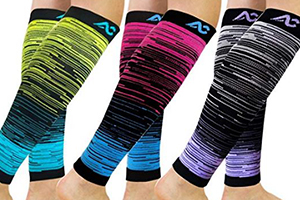
- Recreational Runners
- Professional Athletes
- Marathoners
- Nurses
- Pregnant Women
- People who Stand a lot at Work
- People who Sit a lot at Work
- People Prone to Leg Swelling
While to most observers, compression sleeves may seem to be a bit ‘extra’, many people are surprised when they learn about the science behind the sleeves. The benefits of wearing compression sleeves, socks and stockings for legs are vast and various.
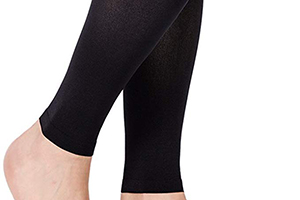
You may have noticed people in races running with compression sleeves on. And you may be wondering if they actually work. Well, the best news you can hear today is that these compression sleeves help in reducing injury to your muscles and also help in a speedy recovery! Plus, they can help with other medical issues as well.
You may also wonder if compression sleeves and compression socks are the same. Compression gear can differ, but the main difference between compression socks and compression sleeves is that compression sleeves only go down the top of your ankle while compression socks go all the way to the bottom of your feet.
How Do Compression Sleeves Work?
Compression therapy helps by improving blood flow from your feet to your legs to your heart. By doing this, it helps in preventing pooling of the blood and other fluids in your legs, reducing the risk of swelling, varicose veins and DVT. In addition, the extra flow of blood to and from the heart means that more oxygenated blood can get to your muscles providing an extra boost to your workout.
To understand how compression sleeves work and how support socks help boost blood flow to heal injury to the calf and knee, it is important to have a basic understanding of how blood flows through your body.
The heart pumps oxygenated blood to the body’s extremities through arteries. Once the cells use the oxygen and other nutrients in the blood, the deoxygenated blood along with lactic acid and other waste products enter the veins to be transported back to the heart. Once it reaches the heart it is oxygenated from the lungs and the whole process is repeated.

The body needs oxygenated blood for performance. To an extent, the more oxygen the cells have, the better they function. During exercise, the body produces lactic acid as a waste product and if the lactic acid is not removed, then it can contribute to soreness, cramping and also decrease the ability to perform.
Another factor that decreases performance is muscle fatigue and this can be avoided by using compression socks or sleeves. Soreness and muscular fatigue are contributed by physical activity. The shock and vibration going through your leg muscle as you pound the pavement while running, over time, adds up and becomes fatigued and sore. Support socks help boost blood flow to heal injury to the calf and knee.
Popular Articles on ComproGear
Best Compression Socks for Edema Best Men’s Compression Socks for Edema
Compression Socks for Circulation
Compression sleeves, socks and stockings work in a variety of ways to keep the circulatory system on track and working as it should. Oxygenated blood is pumped from the heart, through the arteries to the muscle cells where oxygen and nutrients are taken up.
The deoxygenated blood is then pumped back to the heart from cells through the capillaries and veins. This reoccurs to form the circulation cycle. The leg’s compression sleeves increase a gentle pressure to the calves gradually, in order to counter the effects of gravity in the same manner support socks help boost blood flow to heal injury to the calf and knee.
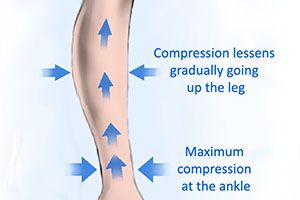
Now that you understand the inner-workings of the body, let’s talk about what compression sleeves do to help the body. Most medical-grade compression socks or sleeves provide graduated compression, meaning the compression pressure is higher at the ankle and foot and loses pressure as you move up the calf and lower leg. This type of compression helps to fight the effects of gravity and assist in the venous return of deoxygenated blood back to the heart. Basically, support socks help boost blood flow to heal injury to the calf and knee.
Scientific studies indicate that with the optimal level of consistent compression to the feet, the walls of the arteries will dilate thus increasing blood circulation. Arterial blood circulation has been shown to increase up to 40% during any activity and by 30% during muscle recovery.
This means that more oxygenated blood will reach your body parts. On the other hand, the walls of the veins will constrict under the compression which helps to increase the velocity of the blood circulation through the veins. This means that deoxygenated blood and lactic acid will be transported back to the heart quicker and thus help increase the rate of recovery and also decrease muscle soreness.

Compression sleeves will also assist in stabilizing the muscle and decrease the amount of muscle vibration which, in turn, decreases muscle fatigue. To sum it all up, the benefits of compression sleeves include enhanced performance through increased blood circulation and speedy recovery. Compression stockings may also decrease muscle fatigue and soreness.
What Do Knee & Calf Support Socks and Leg Sleeves Do?
- Improve Circulation to the Limbs
- Boost Running Performance
- Boost Recovery after Workout
- Pain Relief
- Improve Lymphatic Drainage
- Alleviate Varicose Veins
- Provide Symptomatic Treatment for DVT
- Support Shins and Calves
- Neutralizes Calf Vibration
- Stabilizes Achilles
- Offers Ligament Support
Benefits of Wearing Compression Sleeves
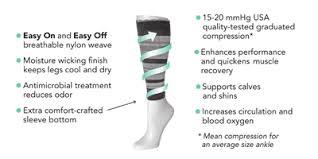
Scientific research shows that wearing compression sleeves or support socks improves blood flow to your muscle cells which improves the amount of oxygen available to you. The more the rate of oxygenated blood flow, the higher the replenishing rate of nutrients and oxygen into the muscle cells. That means more power for higher endurance and stamina levels to walk or run throughout the day.
Compression sleeves offer a variety of benefits to users. It provides pressure to the ankles and calves thus reducing swelling and aching of the legs. The compression pressure applied helps improve blood circulation in your legs back to your heart.
Following are some of the other benefits offered by compression tights:
Comfort
People in occupations such as nursing may experience muscle fatigue due to the long and strenuous activity involved. These people are at a higher risk of developing leg swelling, or pooling of the blood at the feet. Generally, support socks improve blood flow to make standing on your feet body more comfortable.
Circulatory Health
Compression sleeves are used as a preventative measure and not to harm you in the long run. For people who spend a lot of time sitting, their circulatory system may be at risk. Wearing compression sleeves and socks can help to promote healthy circulation and reduce the risk of developing blood clots or deep vein thrombosis (DVT) in those who are vulnerable.
Compression stockings will reduce the chances of blood pooling at the feet and reducing the chances of developing Varicose veins. This is why doctors recommend using compression stockings whenever you suffer from varicose veins and DVT. But as warned earlier, make sure that you check with your doctor if the compression stocking you want to purchase is perfect for you. You do not want to suffer the consequences of wrong compression strengths.
Athletic performance
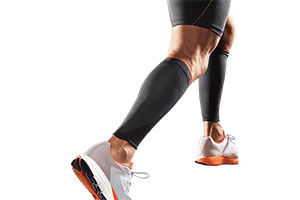
Wearing compression stockings during and following workouts will help to improve muscle recovery. Wearing the sleeves will also naturally alleviate lactic acid from building up and reduce wear and tear on the muscle.
The science behind compression sleeves ensures that the blood circulation is optimum when using these socks. As stated earlier, the compression pressure at the ankle is high and gradually reduces as you move up your leg. Using compression sleeves help in reducing pooling of the blood and the vibration to the muscles as you go on your sporting activity.
Through compression stockings, athletes can complete sporting activities with reduced muscle fatigue and soreness. You can recover effectively by wearing support socks to improve blood flow to prevent injury to the knee and calf. Although there is not much scientific research yet, many athletes testify to the fact that compression stockings work by improving athletic performance.
Speedy Injury recovery
Doctors recommend using compression socks to naturally stimulate the healing of the body. Compression stockings are helpful after a patient has undergone surgery and when managing chronic illnesses and pain. But be sure to consult your healthcare provider as compression socks are not recommended for some medical conditions.

The compression pressure applied to the feet and calves ensure that the blood circulates smoothly. Therefore, support socks improve blood flow to prevent injury to the knee and calf.
Maternity relief

Pregnant women will often be able to find relief from aching and swollen feet when they use compression hosiery. The compression stockings and sleeves offer a comfortable, cooling effect and are easy to put on. Not only that, but compression socks help to prevent the development of varicose veins that can be prevalent during pregnancy.
In addition, pregnant women who are placed on bed rest may be at a higher risk of developing blood clots in their legs. Compression sleeves and socks are extremely helpful in preventing this dangerous health risk.
Precautions for Compression Sleeves
Not everyone is engineered in the same way and some of us do have medical conditions that can hinder us from performing optimally. So, make sure that you get your doctor’s advice before selecting your compression sleeve. This is because using compression stockings while diagnosed with these conditions can do more harm than good.
Compression Sleeve Sizes
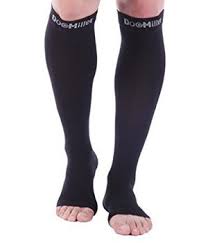
Compression socks with lower compression levels can be purchased online or in your local pharmacy, but stronger compression strengths need a doctor’s prescription. When wearing these sleeves, it should feel like a tiny hug on your legs which will result in better blood flow.
The calf size is the primary consideration in choosing a compression sleeve since the correct size support socks improve blood flow to prevent injury to the knee and calf. You will need a tape measure in order to determine exactly what size compression sock you will need. You may also need to consult with a physician or pharmacist. When a considered compression sleeve is in between sizes, it is advisable to size down.
Characteristics of Best Compression Sleeves
Here, we’ll take a look at the characteristics of the most effective compression sleeves.
Fit
For comfortably moving around, a pair of perfectly fitting calf compression sleeves are necessary to provide the needed support, and also good fitting support socks improve blood flow to prevent injury to the knee and calf. There are diverse options from which to chose from.
Based on gender; there are some for males, some for females and others are unisex. Based on support; there are some for prescription strength, while others are light support leg compression sleeves. The ultimate selection should meet your needs and what you plan to use them for. Each manufacturer should provide you with a size guide to help you discern which will work.
When you have the option, it’s best to buy from a company, like Comprogear, that provides a 100% customer satisfaction guarantee. That way, if the fit isn’t right, you can return them for a pair that does fit.
Design Material
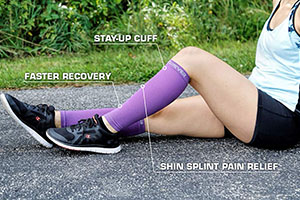
Leg compression sleeves come in different material varieties depending on the intended purpose. While some compression sleeves are made to treat varicose veins, some are used for training by athletes, while others are used in gyms for muscle recovery after workout. Try a sleeve that is made out of a stretchy, durable material, such as nylon and spandex.
For those who plan to exercise in their compression sleeves or socks, it is advisable to consider those with anti-odor and moisture absorbent properties. There are compression sleeves made from more technical materials for prospective users who may have troubling conditions, such as shin splints.
Style
If you’re going to wear a compression sleeve, you should look good doing it! Varied options, prints and patterns exist, all dependent on your personal choice of style. From simpler types, to elaborate, outstanding types, compression socks and sleeves have it all!
When selecting a compression sleeve, you should check to see if it fits your style. You should go for sleeves which will blend in with your attire. Compression sleeves come in various styles which include ankle socks, knee-high and thigh-high. Many retailers will offer choices when you go to buy your compression stocking.
Compression Strength

Another characteristic of the best compression sleeve is the compression strength chosen. There are different levels of compression pressure applied to the ankle and all depends on your need. Many retailers will stock all these grades and you need to find the right compression pressure to benefit from these sleeves.
The level of compression you need will depend on your need for compression socks. the standard levels as mentioned include:
- Light-moderate compression, 15-20 mmHg – these are perfect for traveling. If your work entails standing all day, pregnant or experiencing mild leg swelling, these types of socks will come in handy. And you will not need a prescription for these.
- A moderate compression, 20-30 mmHg – these are great for legs that experience moderate swelling and varicose veins because of pregnancy or another condition. You can also wear them when your legs feel tired and heavy. Your doctor may need to write you a prescription in order to purchase this compression level.
- Firm compression, 30-40 mmHg – these are usually required when you have moderate to severe varicose veins, moderate edema, or after vein treatment such as vein stripping. They also come in handy for combating lymphedema. These require a prescription.
- Extra firm compression, 40-50 mmHg – they help with severe edema, or varicose veins, chronic venous diseases or severe post-thrombotic syndrome. These are rarely used and only for severe cases.
- Heavy compression, 50-60 mmHg – this is the strongest standard compression level and is primarily used in relieving Post Thrombotic Syndrome and lymphedema.
Make sure that you get the right compression strength. For the low compression levels, you do not need a doctor’s prescription, However, the stronger the compression pressure make sure that you get advice from your health facility. Stronger strengths can do more harm than good if not used properly.
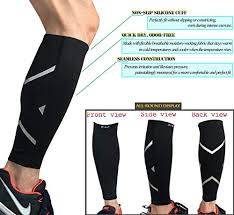
Are Compression Sleeves Good for Your Health?
Though compression sleeves do not totally do away with the need for a proper rest for an injured leg, or substitute massage, they do offer a wider range of protective capabilities. Compression sleeves cushion the lower leg from scrapes and bumps, whilst offering the unique ability of support and protection to the calf region. And with health benefits that include prevention of varicose veins or blood clots as well as reducing swelling, you really can’t go wrong with compression socks and sleeves!
Compression sleeves or stockings offer a wide variety of benefits to the healthy and the injured. The increased blood circulation will increase your performance and decrease the rate of fatigue of the muscles. It will also help you recover from an injury quicker so that you can be ready for your next activity.
This page last updated December 15, 2022
